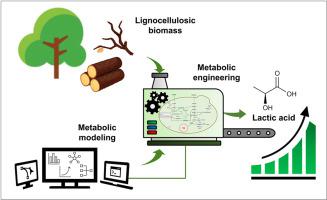当前位置:
X-MOL 学术
›
Metab. Eng.
›
论文详情
Our official English website, www.x-mol.net, welcomes your
feedback! (Note: you will need to create a separate account there.)
Engineering of Saccharomyces cerevisiae for enhanced metabolic robustness and L-lactic acid production from lignocellulosic biomass
Metabolic Engineering ( IF 6.8 ) Pub Date : 2024-05-23 , DOI: 10.1016/j.ymben.2024.05.003 Bohyun Choi 1 , Albert Tafur Rangel 2 , Eduard J Kerkhoven 3 , Yvonne Nygård 4
Metabolic Engineering ( IF 6.8 ) Pub Date : 2024-05-23 , DOI: 10.1016/j.ymben.2024.05.003 Bohyun Choi 1 , Albert Tafur Rangel 2 , Eduard J Kerkhoven 3 , Yvonne Nygård 4
Affiliation

|
Metabolic engineering for high productivity and increased robustness is needed to enable sustainable biomanufacturing of lactic acid from lignocellulosic biomass. Lactic acid is an important commodity chemical used for instance as a monomer for production of polylactic acid, a biodegradable polymer. Here, rational and model-based optimization was used to engineer a diploid, xylose fermenting strain to produce L-lactic acid. The metabolic flux was steered towards lactic acid through the introduction of multiple lactate dehydrogenase encoding genes while deleting , , and . A production of 93 g/L of lactic acid with a yield of 0.84 g/g was achieved using xylose as the carbon source. To increase xylose utilization and reduce acetic acid synthesis, and were also deleted from the strain. Finally, encoding a pyruvate kinase was overexpressed, resulting in a yield of 0.75 g lactic acid/g sugars consumed, when the substrate used was a synthetic lignocellulosic hydrolysate medium, containing hexoses, pentoses and inhibitors such as acetate and furfural. Notably, modeling also provided leads for understanding the influence of oxygen in lactic acid production. High lactic acid production from xylose, at oxygen-limitation could be explained by a reduced flux through the oxidative phosphorylation pathway. On the contrast, higher oxygen levels were beneficial for lactic acid production with the synthetic hydrolysate medium, likely as higher ATP concentrations are needed for tolerating the inhibitors therein. The work highlights the potential of for industrial production of lactic acid from lignocellulosic biomass.
中文翻译:

酿酒酵母工程增强代谢稳健性和从木质纤维素生物质生产 L-乳酸
为了实现从木质纤维素生物质可持续生物制造乳酸,需要实现高生产率和增强稳健性的代谢工程。乳酸是一种重要的商品化学品,例如用作生产聚乳酸(一种可生物降解的聚合物)的单体。在这里,使用理性和基于模型的优化来设计二倍体木糖发酵菌株来生产 L-乳酸。通过引入多个乳酸脱氢酶编码基因,同时删除 、 和 ,将代谢流转向乳酸。使用木糖作为碳源,实现了 93 g/L 乳酸的生产,产率为 0.84 g/g。为增加木糖利用率并减少乙酸合成,也从菌株中删除。最后,当使用的底物是含有己糖、戊糖和抑制剂(例如乙酸盐和糠醛)的合成木质纤维素水解产物培养基时,编码丙酮酸激酶被过度表达,导致0.75g乳酸/g消耗的糖的产量。值得注意的是,建模还为理解氧气对乳酸生产的影响提供了线索。在氧限制下,木糖产生的高乳酸可以通过氧化磷酸化途径的通量减少来解释。相反,较高的氧气水平有利于合成水解产物培养基的乳酸生产,可能是因为需要较高的 ATP 浓度来耐受其中的抑制剂。这项工作强调了从木质纤维素生物质工业生产乳酸的潜力。
更新日期:2024-05-23
中文翻译:

酿酒酵母工程增强代谢稳健性和从木质纤维素生物质生产 L-乳酸
为了实现从木质纤维素生物质可持续生物制造乳酸,需要实现高生产率和增强稳健性的代谢工程。乳酸是一种重要的商品化学品,例如用作生产聚乳酸(一种可生物降解的聚合物)的单体。在这里,使用理性和基于模型的优化来设计二倍体木糖发酵菌株来生产 L-乳酸。通过引入多个乳酸脱氢酶编码基因,同时删除 、 和 ,将代谢流转向乳酸。使用木糖作为碳源,实现了 93 g/L 乳酸的生产,产率为 0.84 g/g。为增加木糖利用率并减少乙酸合成,也从菌株中删除。最后,当使用的底物是含有己糖、戊糖和抑制剂(例如乙酸盐和糠醛)的合成木质纤维素水解产物培养基时,编码丙酮酸激酶被过度表达,导致0.75g乳酸/g消耗的糖的产量。值得注意的是,建模还为理解氧气对乳酸生产的影响提供了线索。在氧限制下,木糖产生的高乳酸可以通过氧化磷酸化途径的通量减少来解释。相反,较高的氧气水平有利于合成水解产物培养基的乳酸生产,可能是因为需要较高的 ATP 浓度来耐受其中的抑制剂。这项工作强调了从木质纤维素生物质工业生产乳酸的潜力。































 京公网安备 11010802027423号
京公网安备 11010802027423号